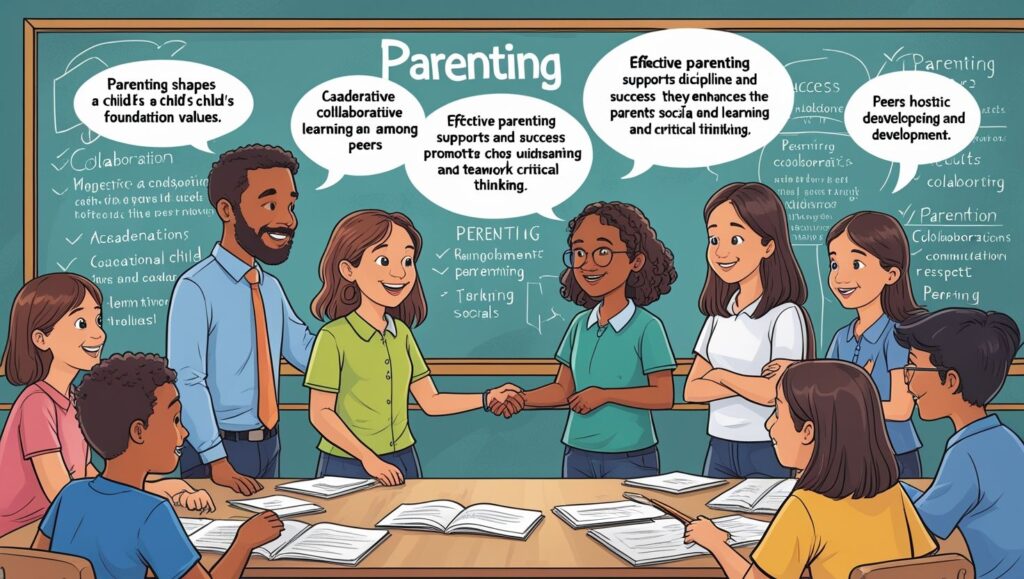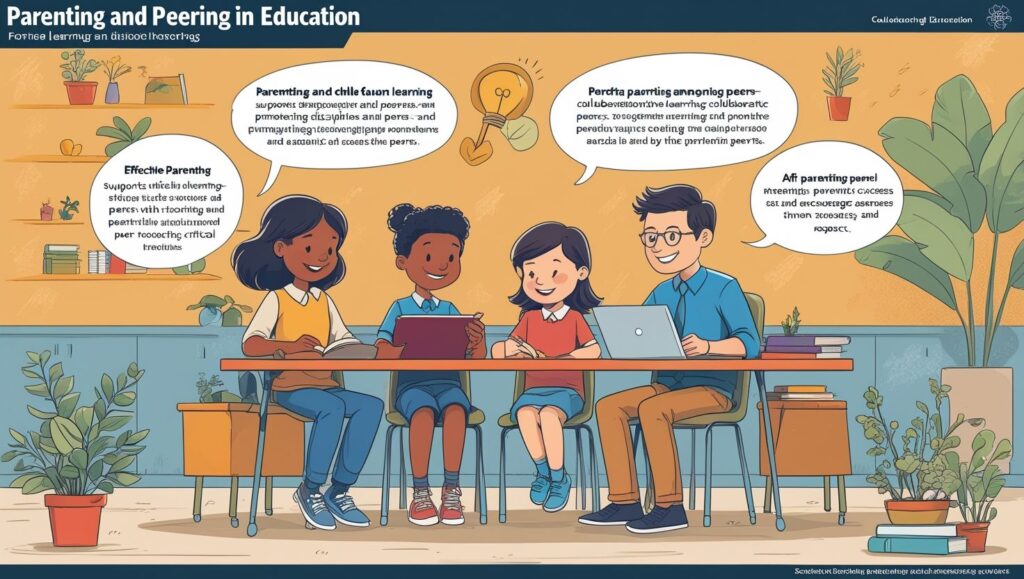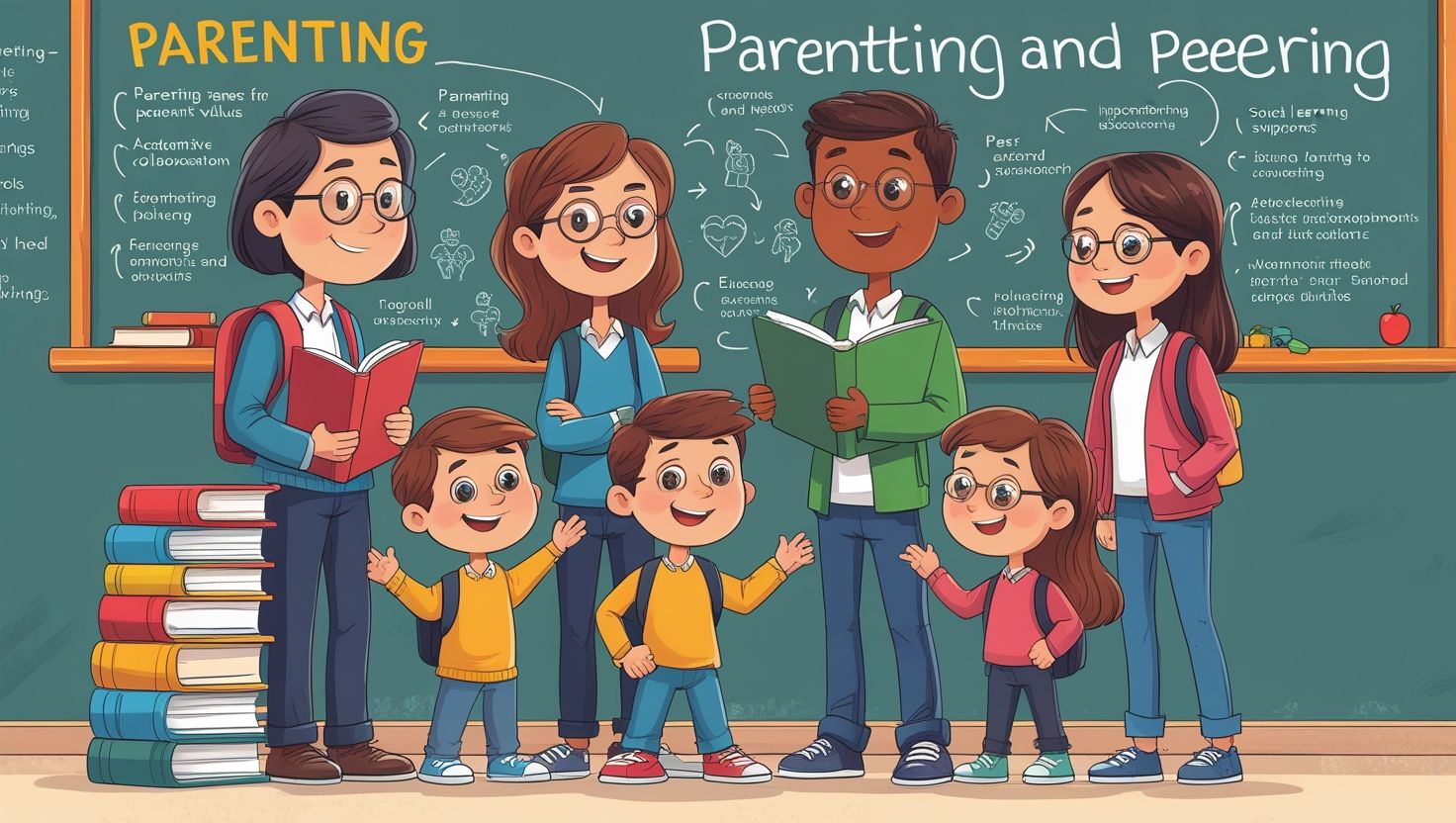1. Introduction to Parenting and Peering in Education
Parenting and Peering in Education, Parenting and peering represent two critical influences on a child’s educational journey. Parenting refers to the family-based support and guidance provided by parents or guardians, encompassing their emotional, academic, and moral nurturing. Peering, on the other hand, involves the interactions and relationships a child forms with peers, which significantly shape behavior, learning attitudes, and social development. In today’s dynamic educational systems, the interplay between parenting and peer influences determines not only academic performance but also cognitive and emotional growth. While schools serve as the formal platform for instruction, parenting sets the tone for motivation and discipline, and peering enriches experiential learning. Understanding these dual forces is essential for educators, psychologists, and policymakers seeking to optimize learning outcomes. Both parenting and peering evolve across developmental stages, necessitating adaptable strategies from stakeholders. This article explores the individual and combined impacts of parenting and peering in educational contexts, examining their benefits, challenges, and implications for policy and classroom practices.
2. The Role of Parenting in Educational Development
Effective parenting plays a foundational role in a child’s learning process. Parents provide the initial exposure to language, communication, values, and behavior patterns. Children who receive consistent parental support tend to exhibit better academic performance, enhanced problem-solving skills, and stronger emotional stability. Parental involvement, such as reading with children, attending school functions, and assisting with homework, has been linked to improved literacy and numeracy skills. Moreover, parents who encourage curiosity, foster a positive attitude toward education, and establish structured routines cultivate intrinsic motivation in their children. Parenting styles—authoritative, authoritarian, permissive, and neglectful—also affect academic outcomes, with authoritative parenting often yielding the most balanced results. Importantly, parenting goes beyond academics; it includes emotional intelligence, resilience, and moral grounding, all of which influence classroom behavior and peer relationships. As digital environments increasingly shape childhood, the parental role also includes monitoring media consumption and guiding responsible technology use. Thus, parenting remains a decisive and long-lasting influence on educational development across all grade levels.

3. The Dynamics of Peer Influence in Learning
Peer groups exert a substantial influence on a student’s behavior, interests, and academic performance, particularly during adolescence. As children grow older, peers often become more significant than family in shaping identity, confidence, and decision-making. Positive peer relationships can enhance academic engagement, foster collaborative learning, and provide emotional support, while negative influences may lead to disengagement, distraction, or deviant behavior. Group projects, discussions, and cooperative tasks in school settings highlight the value of peer-to-peer learning. Peer acceptance, encouragement, and competition contribute to motivation and cognitive development. On the other hand, peer pressure can also induce anxiety, conformity, or risky behaviors, particularly in environments lacking strong adult guidance. The rise of social media intensifies these dynamics, as online peer interactions can extend both support and stress beyond the classroom. Educators must therefore promote inclusive, respectful, and academically stimulating peer interactions. Peer mentoring programs, conflict resolution strategies, and structured group work can help harness the positive aspects of peering while minimizing its potential harms.
4. Parenting Styles and Educational Outcomes
Parenting styles significantly affect children’s academic achievements and social skills. Authoritative parents, characterized by warmth, responsiveness, and clear expectations, are most consistently associated with high student performance and emotional well-being. Their children tend to be independent, motivated, and respectful of authority. In contrast, authoritarian parents, who emphasize obedience over dialogue, may produce compliant children with lower self-esteem and creativity. Permissive parenting, marked by high warmth but little discipline, can lead to poor academic habits and weak impulse control. Neglectful parenting, with minimal involvement, is associated with academic failure, behavioral issues, and social withdrawal. These styles impact not only direct interactions at home but also how children respond to teachers, peers, and academic challenges. For example, children of authoritative parents often seek help when needed and value education as a shared goal. School-parent collaboration can be optimized when educators understand family dynamics and communicate effectively. Tailoring engagement strategies to align with parental approaches can enhance student support and learning consistency at home and school.
5. Social Learning and Peer Modeling
Social learning theory posits that children acquire knowledge and behaviors through observation, imitation, and modeling, especially from peers. In educational contexts, students often emulate the study habits, language, and problem-solving strategies of classmates they admire or relate to. This peer modeling can positively reinforce academic engagement when high-achieving students set examples of diligence and curiosity. Conversely, disruptive or disinterested peers can influence classmates to adopt similar behaviors, especially in unstructured environments. The presence of role models within peer groups is crucial in shaping group norms. Cooperative learning environments capitalize on peer modeling by encouraging group members to teach and support each other. Teachers who strategically compose groups with diverse skill levels can promote mutual learning and reduce performance gaps. Additionally, peer tutoring and buddy systems enable students to explain concepts in relatable terms, often increasing comprehension and retention. Recognizing the potential of peer influence, educators should design classroom settings and school cultures that favor constructive social learning and diminish unhealthy peer dynamics.
6. Collaborative Learning and Peer Support
Collaborative learning enables students to work in teams, share ideas, and collectively solve problems, fostering both academic and social growth. Through peer collaboration, learners benefit from diverse perspectives, reciprocal teaching, and mutual encouragement. This environment enhances communication skills, empathy, and critical thinking. Research shows that students engaged in group learning retain information longer and perform better on complex tasks than those studying individually. Peer support also helps reduce academic anxiety and promotes a sense of belonging, especially among students from marginalized or minority backgrounds. Moreover, peers often bridge the gap between formal instruction and personal understanding, making learning more relatable. Teachers play a key role in structuring group tasks, setting clear objectives, and facilitating equitable participation. Challenges in collaborative learning include managing group conflicts, uneven contributions, and off-task behavior, which require effective classroom management strategies. When implemented thoughtfully, collaborative learning not only improves academic performance but also cultivates life skills essential for teamwork, leadership, and adaptability in diverse environments.

7. Parent-Teacher Partnerships for Academic Success
Strong parent-teacher partnerships are essential for reinforcing student learning and development. Open communication between parents and educators fosters consistency in expectations, behavior management, and academic goals. When parents are informed about classroom curricula, assessments, and their child’s progress, they can better support learning at home. Likewise, teachers gain valuable insight into a student’s background, strengths, and challenges through parental input. Parent-teacher conferences, digital communication tools, and school events provide opportunities for such collaboration. Involving parents in school governance, such as through parent-teacher associations (PTAs), further strengthens educational outcomes. Research confirms that students with actively engaged parents have higher attendance rates, better academic performance, and improved behavior. Barriers such as language, cultural differences, or work schedules can limit parental involvement, but flexible strategies—like translated materials or virtual meetings—can address these challenges. Educators and school leaders must foster inclusive and welcoming environments that value parental contributions. Ultimately, partnerships built on mutual respect and shared responsibility benefit students’ academic and personal growth.
8. Impact of Peer Culture on Learning Attitudes
Peer culture encompasses the shared beliefs, values, and behaviors that emerge within student groups and significantly influence learning attitudes. In any school setting, subcultures form based on academic interests, hobbies, language, or socio-economic backgrounds. These cultures often dictate what is deemed “cool” or acceptable, influencing participation in class, attitudes toward achievement, and interactions with authority. A peer culture that celebrates academic excellence, curiosity, and effort encourages students to engage more actively with learning. Conversely, a culture that ridicules hard work or stigmatizes success may lead students to underperform to fit in. Social media amplifies peer culture, often shaping identity and self-worth based on virtual interactions and validation. Teachers and school counselors must understand these peer dynamics to address issues like bullying, exclusion, or peer pressure. Fostering inclusive school cultures where diversity is respected and academic engagement is normalized helps all students thrive. Peer-led clubs, leadership opportunities, and inclusive curriculum choices can positively shape peer culture and enhance school climate.
9. Parenting in the Digital Age and Education
Modern parenting involves navigating the complexities of digital technology, which significantly impacts children’s educational experiences. The internet offers vast educational resources, interactive learning platforms, and virtual classrooms, enhancing access and engagement. However, unsupervised or excessive screen time can lead to distraction, misinformation, and reduced physical activity. Parents play a vital role in mediating children’s technology use by setting boundaries, monitoring content, and promoting educational applications. Digital literacy among parents enables them to support their children in using online tools effectively and safely. Additionally, online schooling and homework platforms often require parental oversight and technical familiarity. The COVID-19 pandemic accelerated the shift to digital learning, highlighting both the opportunities and inequalities associated with home-based education. Families with limited internet access or digital skills faced substantial challenges, underscoring the importance of parental support and digital inclusion initiatives. In the digital age, parenting must balance openness with supervision, ensuring that children develop both technological proficiency and responsible, focused learning habits.
10. Peer Relationships and Emotional Intelligence
Peer interactions play a central role in developing emotional intelligence (EI), which includes self-awareness, empathy, emotional regulation, and social skills. Through friendships, conflicts, and group activities, students learn to understand emotions, resolve disagreements, and support others. High EI contributes to academic success by improving concentration, resilience, and interpersonal communication. Schools that promote social-emotional learning (SEL) programs help students navigate peer relationships more constructively. Peer feedback and collaboration expose students to differing viewpoints, promoting empathy and tolerance. However, negative peer experiences such as bullying, exclusion, or social anxiety can impair emotional development and academic motivation. Teachers and counselors must be attentive to group dynamics and intervene when peer issues arise. Encouraging inclusive practices, peer mediation programs, and emotional coaching can build healthier classroom environments. As students progress through educational stages, emotionally intelligent peer interactions foster leadership, conflict resolution, and team-building abilities—key competencies for both academic achievement and future career success.
11. Integrating Parenting and Peering in Educational Strategies
Effective educational strategies must consider the combined influence of parenting and peering. While parents provide the foundation for discipline, values, and learning habits, peers offer socialization, collaboration, and identity formation. Integrating both aspects requires schools to engage families and create supportive peer environments. For example, project-based learning with parental involvement and peer collaboration merges both influences effectively. Parent education programs can align home strategies with classroom methods, ensuring continuity in discipline and motivation. Similarly, student leadership initiatives and mentorship programs utilize peer influence positively. Teachers can design learning tasks that encourage peer support and allow parents to contribute based on their expertise or availability. Moreover, school-wide frameworks like Positive Behavioral Interventions and Supports (PBIS) blend parenting styles and peer norms into a unified approach. Recognizing the mutual reinforcement of parenting and peering enables educators to create a more holistic and effective learning environment, where both home and peer settings contribute to student achievement and well-being.
12. Conclusion:
Parenting and peering together form the social bedrock of a child’s educational experience. While parenting offers structure, motivation, and moral direction, peer influence adds social learning, collaboration, and adaptability. Educators must acknowledge and integrate both forces into curriculum design, classroom management, and student support systems. The synergy between home and peer environments can enhance academic performance, emotional resilience, and lifelong learning skills. Effective communication, collaboration, and cultural sensitivity are key to leveraging these relationships. As societies and technologies evolve, both parenting practices and peer interactions continue to shift, requiring flexible and responsive educational policies. Schools should empower parents and guide peer groups to promote positive behavior, critical thinking, and inclusivity. By understanding and addressing the roles of parenting and peering, educators and policymakers can foster a more supportive, equitable, and dynamic learning environment for every student. This dual approach not only boosts academic achievement but also nurtures compassionate, responsible, and socially capable individuals equipped for the challenges of the future.

You’ve turned what could have been a generic topic into something memorable. Your passion and dedication really come through.